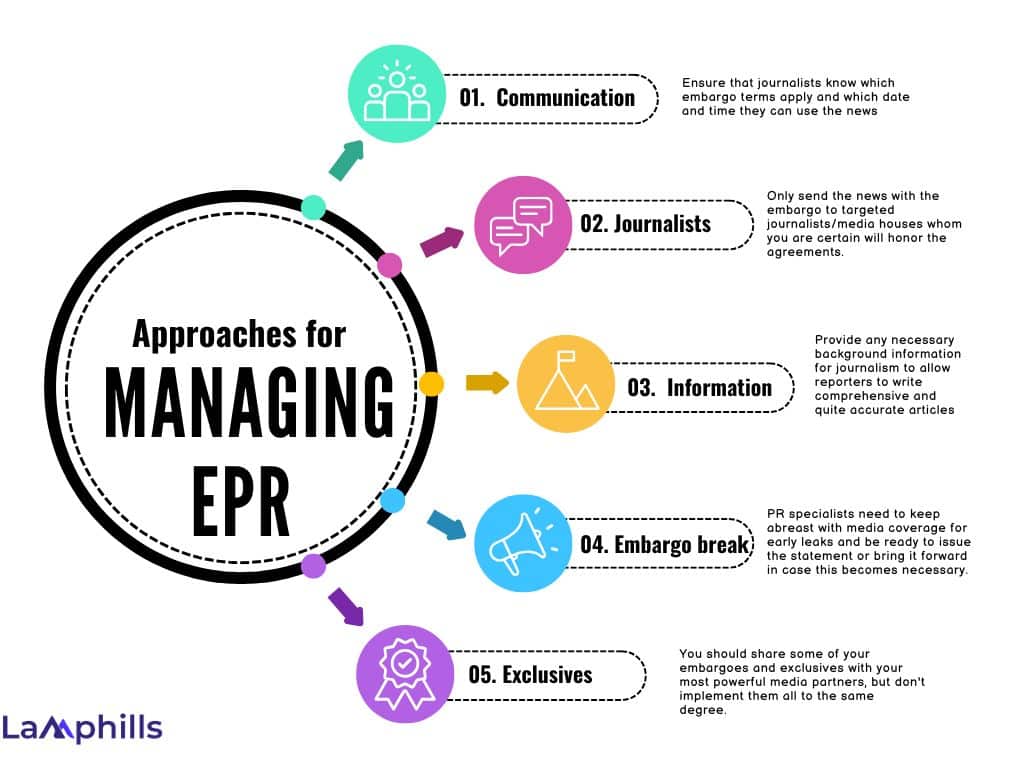I used to supervise product releases at a tech company where I worked. One day, we were preparing to notify users worldwide about an upcoming software release. Our goal was to create a buzz while maintaining control over the narrative, so we used a PR embargo. This allowed us to share the news with journalists and influencers in advance, but they couldn’t publish anything until the official launch. It gave us time to align messaging, build anticipation, and ensure maximum impact. Why PR Embargoes Matter: A guide for PR Professionals—PR embargoes help control timing, ensure consistent messaging, and avoid leaks, maximizing media coverage at the right moment.
Key Points
- PR embargoes enable companies to dictate the timing of their announcements, ensuring simultaneous coverage by various media outlets, which enhances suspense and maximizes impact.
- By using embargoes, companies can prevent leaks and conflicting narratives, allowing journalists ample time to create accurate stories with essential background information and resources.
- Embargoes create a feeling of exclusivity for journalists, enhancing the perceived importance of the news and ensuring it receives the attention it deserves in a crowded news cycle.
- When embargoes are managed well, they facilitate coordinated coverage across major publications, increasing brand visibility and fostering trust between PR professionals and journalists for future collaborations.
PR Embargo
EPRs, or embargo press releases, are among the most widely used and criticized public relations strategies. PR professionals and journalists usually have clear opinions about managing embargoes.
Embargo press releases are not as common as perhaps ten years ago for several reasons, but the use of information technology and social networking to disseminate the news speeds up the news cycle.
This allows journalists to take time while developing special or difficult news stories, besides ensuring that the individual or business release story is safe.
Not every news release, however, uses embargo press releases. They are totally unnecessary if the narrative is simple and understandable to anybody.
Embargoes are best when there is a real benefit to using them. On the other hand, you run the risk of publications ignoring your embargoes or blocking your requests completely if you apply them to every news article or overuse them in your media pitches.
Companies can use a PR embargo as a powerful tool to control how they release a piece of news. It can be useful when introducing a new service or product, publishing a financial report, or a change in a company’s management. Since there is a specified day and time, PR professionals know when the news can go out so they can organize with various media outlets. This approach puts out a unified message, thereby fostering a harmonized buzz and more effective publicity.
Why do PR Embargoes Matter?
In some cases, PR embargoes are required to allow a brand to schedule the release of controversial material, coordinate messaging across several channels, and monitor the landscaping to maximize media coverage. It is now time to discuss why these embargoes are necessary to public relations.
Quick read: PR BUSINESS: Shaping Perceptions and Building Brands Through Public Relations (The People’s Voice)
#1. Control Over News Timing
PR embargo allows companies to have complete discretion when their announcement is out there for the public. For instance, when a company releases a new product, it may want all the newspapers, magazines, radio, and television stations to write, publish, and broadcast the story simultaneously. This enhances the suspense and guarantees that the story cannot continue at full speed and in force. In the tech world, this is standard practice. Embargoes guarantee that all the major tech news sites release their reviews simultaneously and make a bigger media splash.
#2. Consistency in Messaging
Today, in the era of advanced technological advancements, a single leak or different narratives at different times affects a campaign. Embargoes help avoid this. When multiple reporters collaborate on related topics that cannot be broadcasted immediately and they share the material, they each gain a comprehensive viewpoint to report from. It helps businesses by providing journalists with essential background material, quotes, and statistics, as well as the graphics they need to write the article. This will allow journalists enough time to create more accurate stories.
#3. Generating a Sense of Urgency
When the content is under embargo, journalists understand that they deal with sensitive material before anyone else. This always gives the story an urgency and importance that it may or may not deserve. When it is big news, they are in a better position to accord it the respect it deserves by making it pop up amid all the daily news.
#4. Amplifying Coverage
Embargoes benefit the PR teams because journalists know they work together to get every scoop from a single source. Likewise, this means that when the news drops, it goes around. This results in a “big bang” effect, where multiple major publications simultaneously release stories, amplifying the brand’s visibility. The simultaneous exposure creates a larger conversation and builds momentum, helping the brand dominate the news cycle for that day.
#5. Building Strong Relationships with Journalists
When implemented properly, embargoes can foster trust between journalists and public relations specialists. Giving a journalist an embargo shows that the company respects its ability to manage delicate material and has faith in its ability to adhere to the release schedule. Strengthening relationships over time will increase the likelihood of future journalists covering your stories.
When to Use PR Embargoes
Of course, there are situations in which PR embargoes are not the only line of action. The success of an announcement depends on how well we time these tools.
#1. Product Launches

PR embargoes are useful in various circumstances, and perhaps the most popular is during product release. For instance, when a tech company producing smartphones is developing a new model, they will set an embargo to ensure that any features, specifications, or reviews are all launched simultaneously. This causes people to talk about the product and prevents other competitors from gaining focus.
Check out this Embargo Press Release Template for Different Sectors
#2. Financial Announcements
Businesses place a PR embargo on earnings reports, mergers, or other significant policy announcements to give stock analysts, the public, and the media adequate time to examine the information and share it with interested parties. It avoids situations where two people understand the communication signals differently, as well as instances where misrepresentation occurs.
#3. Research or Industry Reports

When releasing new research or industry reports, an embargo allows time for journalists to review the data, interview key players, and prepare comprehensive stories. Embargoes are especially useful here, as they ensure the research findings are accurate.
#4. Crisis Management
There is also an added benefit where embargoes can give the company a head start on preparing their messages, particularly in areas like recalls, company scandals, or legal issues, while guaranteeing the journalist they are getting the complete story. This way, the organization guides the dynamics of the conversation and can also curb the spread of fake news.
Embargoes, particularly, work well if you have a significant announcement that you’d like the journalist(s) to prepare a story for in advance. The general concept of the embargo is that you let the journalist do their work in advance to reach the situation where the story would come out right after your news hits the web. This time allows for the development of a more complete and higher quality story, as well as better design and thought-out features.
It would, however, be important to note that the keyword employed here is “news.” This means that if you intend to get reporters interested, then you have to be offering them material that is well suited to the news rather than just corporate ideas. Reporters find events like new product releases, new key appointments, and new surveys or studies highly interesting.
Recommended approaches for managing PR embargoes.

Embargos are feasible for management. Here are some best practices for using them effectively:
#1. Clear communication
Ensure that journalists know which embargo terms apply and which date and time they can use the news. The PR experts should include this information early in the press release and email subject line.
#2. Select the right journalists
Only send the news with the embargo to targeted journalists/media houses whom you are certain will honor the agreements. Violations of the embargo may negatively impact the journalist and the general PR campaign.
#3. Offer detailed information
Provide any necessary background information for journalism to allow reporters to write comprehensive and quite accurate articles. Ensure that the company representatives, videos, visuals, and data are available so that they can follow the announcements.
#4. Monitor embargo breaks
Unfortunately, embargoes occasionally fail. PR specialists need to keep abreast with media coverage for early leaks and be ready to issue the statement or bring it forward in case this becomes necessary. That is why a contingency plan is necessary in such circumstances.
#5. Offer exclusives sparingly
While embargoes help distribute news broadly, offering exclusive interviews or content to key journalists can help your story stand out. You should share some of your embargoes and exclusives with your most powerful media partners, but don’t implement them all to the same degree.
Real-World Examples of PR Embargoes
Many successful campaigns have relied on embargoes to control the release of crucial information.
#1. Apple’s iPhone launches:
Apple’s corporate policy is famous for using embargoes even with the technology reviewers. The reviewers themselves get the new iPhone weeks before the specified arrangement to release the reviewing information. This means that as soon as the embargo lifts, coverage follows.
Check out this interesting video from 2012 about an embargoed press release on the iPhone 5! It offers insights into how major product launches are managed and the strategic importance of timing in PR announcements. Watch the video to understand how embargoes help build anticipation and control the narrative before a big tech release. Perfect for those interested in PR strategies around product launches!
#2. NASA Announcements:
They do this especially when announcing breakthroughs in space or about missions by the space agency. Embargoes guarantee that journalists and scientists have time to examine the histories and develop relevant articles.
#3. Academic Journals:
Many highly ranked academic journals, such as Nature or The Lancet, apply embargoes to eagerly awaited research. Using these embargoes makes it easier for the media to grasp findings and present excellent reports.
What is a PR Embargo?
An embargo in public relations refers to a deal reached between a source and a reporter or media organization. It states that until a specified day and time, the supplied information will not be made public.
What is an Embargo in Marketing?
In general, the term embargo in marketing is the limited number of rules involving the withholding of information before an announcement or a product release. The idea of an embargo is that all the information is to be given out at once to eliminate a chance of one or several outlets getting some information heads-up over others.
For instance, an organization may extend an embargo on a new product release by requiring the press not to publish the information until the embargo is lifted. This enables the company to manage the information, and when the product launches, the market will know.
Bottom Line: Why PR Embargoes Still Matter
Undoubtedly, in today’s rapidly changing news environment, PR embargoes are a good way to help brands master their message and ramp up their visibility. When used effectively, they produce a harmonized release that gets sufficient coverage and helps build trust with the journalists. An understanding of this practice as a PR manager leads to effective campaigns.
Related Posts
- How to Write News Release: Free Tips and Examples
- BEST TIME TO SEND A PRESS RELEASE ACCORDING TO YOUR AUDIENCE
- 15+ Good Press Release Topic Ideas to Gain Media Attention for Your Business
- How to Calculate Social Media Impressions in 2024






